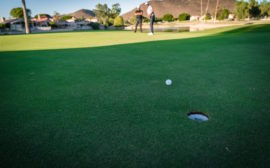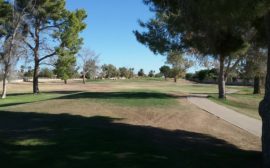Warm Weather Grasses
Growing up in Hawaii, I had the pleasure of playing many types of warm weather grasses. Warm weather grasses differ from cool weather grasses because of the tolerance to heat, blade width, root system, and thatch level. You will see warm weather grasses mostly in southern and tropical states.
Tolerance to Heat
Warm weather grasses tend to withstand heat better than cool weather grasses. As summer comes around in the Valley of the Sun, you will see more of the Bermuda and less of the rye because the rye will burn out and die. Some southern courses like Augusta National Golf Club use cold weather grasses year round with help from cooling systems beneath the roots.
Blade Width and Grain Direction
To accommodate the heat, warm weather grasses have a larger blade width. This makes the grass lay in a certain direction called the grain. Factors that influence grain are wind direction, slopes, nearest body of water, and the position of the sun. Usually grass will grow in the direction of the wind, the natural camber of the land, toward the nearest body of water, and following the position of the sun.
Before I step on the green, I will look for these factors to give me an idea on where the grain is growing. A good indication of grain direction is a “burnt edge” on one side of the hole. The side with the burnt edge is the direction the grain is growing.
Root System and Thatch Level
What is thatch? Thatch is an organic layer of matter that forms around the base of the blades of grass. Warm weather grasses have a larger thatch because it grows from a single root system which means that multiple blades of grass with grow from a single root. Cool weather grasses have individual root systems which means that one blade of grass will have its own root. This is the reason why divots taken off of warm weather grasses are not as uniformed as cool weather grasses. Having this type of root system and thatch level makes the ball sit up a little better in the fairways and in the rough.
Common Types of Warm Weather Grasses
Bermuda:
This is the most common type of grass you will find playing in the south and tropical climates. It is a very traditional grass with the smallest blade width out of all the warm weather grasses. Most courses will grow a common Bermuda in the fairways and a dwarfed Bermuda on the greens which has a smaller grain almost playing like bent grass.
Kikuyu:
Usually not a grass used on greens but more courses are switching to this type of grass in their fairways and rough because of the tolerance to traffic. Kikuyu grass is very dense and wiry. It is widely regarded as one of the toughest rough to play out of on Tour.
Seashore Paspalum:
This grass is very sticky meaning it makes for slower greens and it holds approach shots very well. It does not have a consistent grain direction making this one of the toughest grass to putt on. You will see a lot of this grass in states near the ocean because its tolerance to salinity. It is very low maintenance and course superintendents will use sea salt as herbicide. A cool fact about paspalum is that sailors brought paspalum to the United States using them as beds on their ships.
Zoysia:
You will find this grass on public courses because of its tolerance to drought and low maintenance. It is a highly regarded grass for fairways, rough, and tee boxes. This grass grows very densely which gives golfers the feel of hitting off of a range mat.
Separating Different Types of Grass
Golf courses like to use a mixture of these grasses for example they will use kikuyu for their fairways and rough but they will use Bermuda for their greens. To have them not take over each other, they will generally have a groove separating each type of grass. This is the groove you see that separates the green from the fringe. Most courses have a local rule where you can take a free drop in the nearest point behind the groove, no closer to the hole.
Any time you plan to play golf in the southern and tropical states, expect to see a wide variety of warm weather grasses. They play much different than cooler weather grasses because of the blade width and root system. Expect the grass to have more resistance especially around the green. Before you go out on the course, make sure you hit some shots on and around the greens to develop a feel for how the grass is playing.




